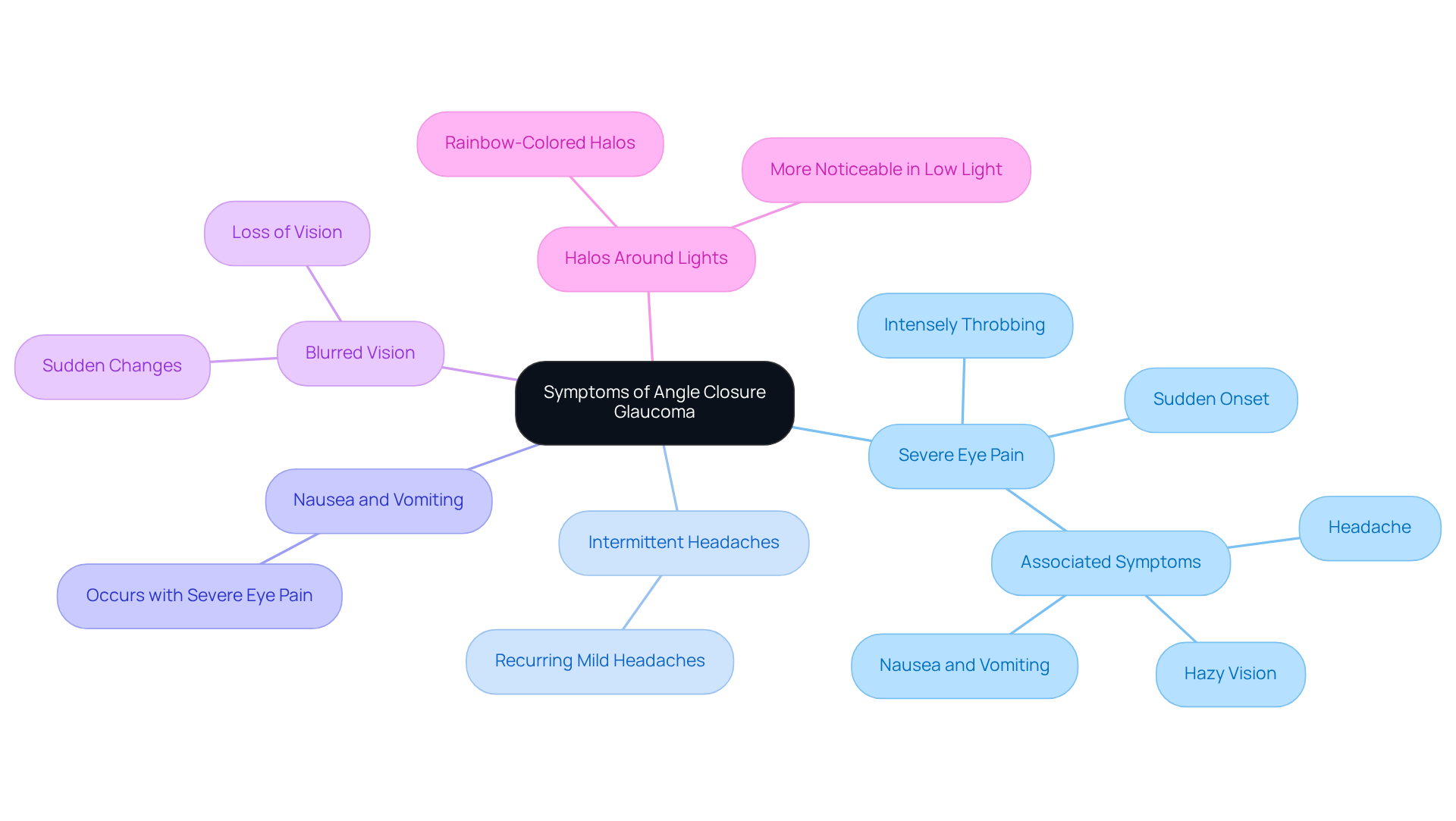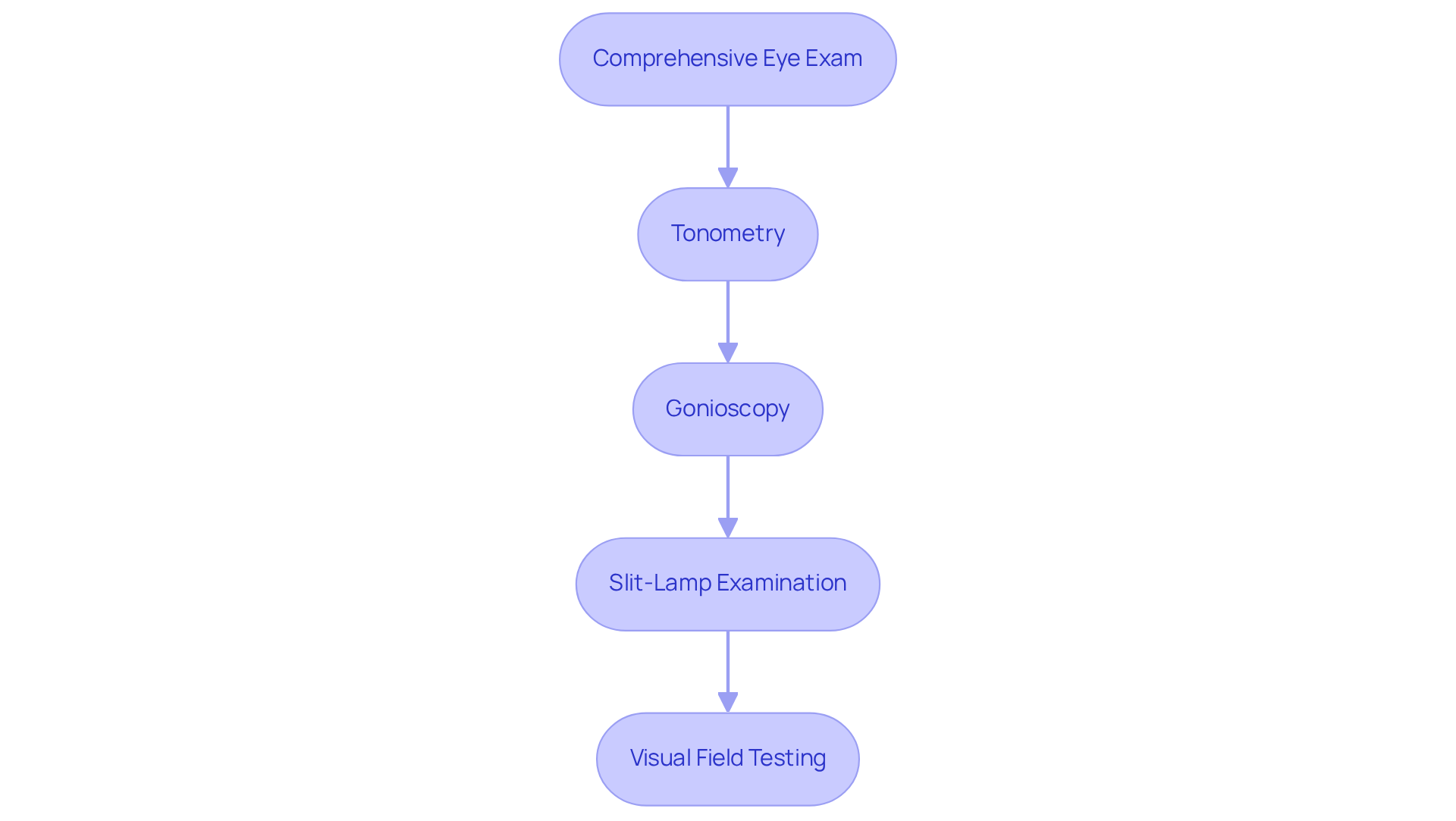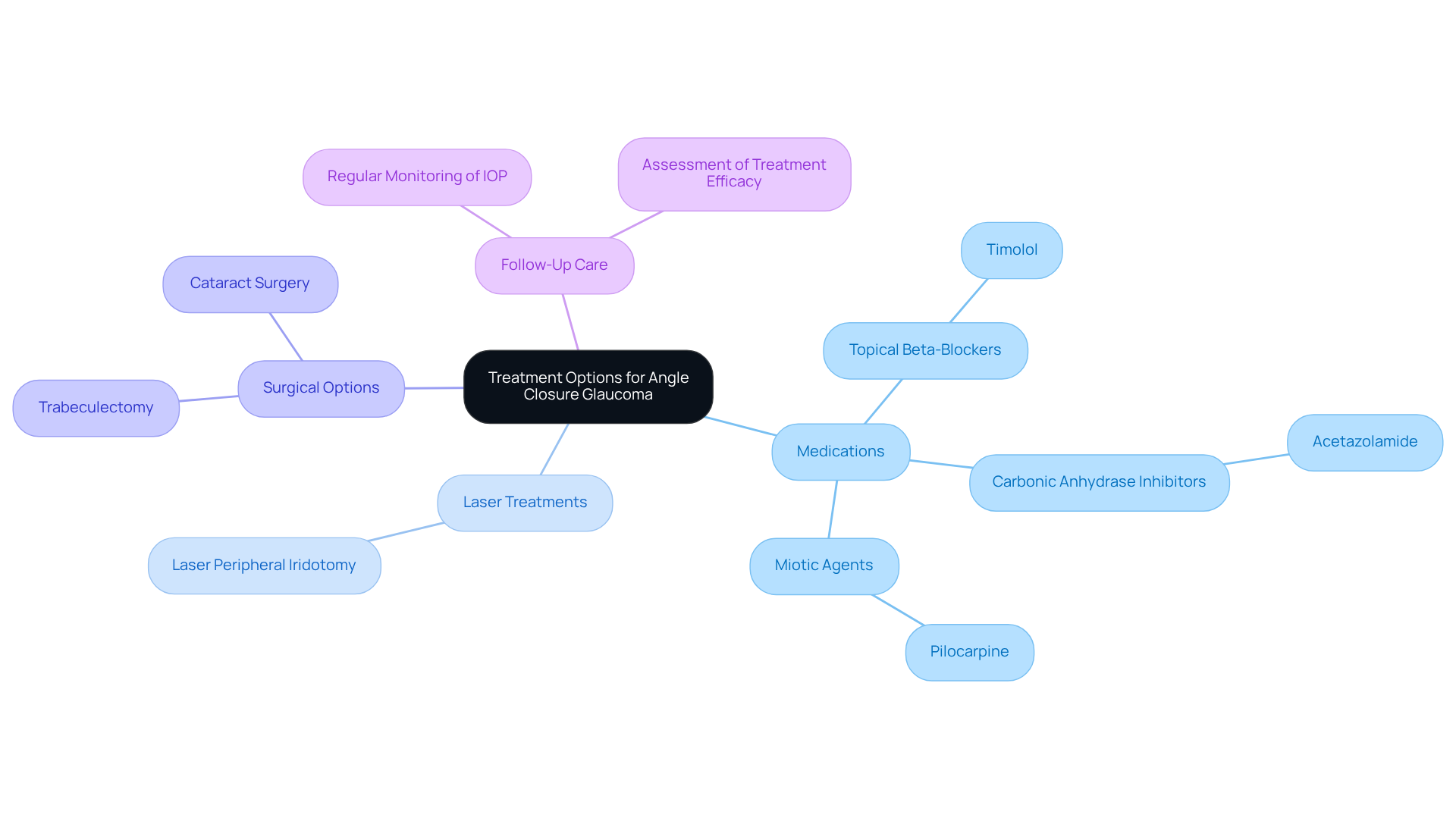Posted by: Northwest Eye in General on July 12, 2025
Overview
Angle closure glaucoma can be a concerning condition, as it involves a blockage in the eye’s drainage pathway. This blockage leads to elevated intraocular pressure, which can result in symptoms that may be quite distressing, such as intense eye pain, nausea, and blurred vision. We understand that experiencing these symptoms can be overwhelming, and it’s crucial to recognize them for early diagnosis and intervention.
In this article, we aim to provide you with the information you need to feel more at ease. We will outline the diagnostic procedures and treatment options available, including medications and surgical interventions. Our goal is to help you effectively manage this serious condition and reassure you that you are not alone in this journey.
Remember, seeking help early can make a significant difference in your experience. We are here to support you every step of the way, ensuring you have access to the care you need.
Introduction
Understanding the intricacies of angle closure glaucoma is crucial, as this eye condition can lead to severe consequences if not addressed promptly. We understand that learning about this condition can be overwhelming. Characterized by a blockage in the drainage pathway, angle closure glaucoma can manifest suddenly with intense symptoms or develop gradually, often going unnoticed until significant damage occurs.
This article delves into the essential aspects of angle closure glaucoma, including:
- Recognizing alarming symptoms
- Undergoing diagnostic procedures
- Exploring effective treatment options
It’s common to feel anxious about your eye health, but we are here to help you through this process.
How can individuals ensure they remain vigilant against this potentially sight-threatening condition? By staying informed and proactive, you can take important steps to protect your vision.
Define Angle Closure Glaucoma: Key Characteristics and Types
Angle obstruction in the eye is a condition that can understandably cause concern. It occurs when the drainage pathway becomes blocked, leading to elevated intraocular pressure (IOP). We want you to know that there are two primary types of angle closure glaucoma that are important to understand:
- Angle closure glaucoma can occur suddenly and is often accompanied by severe symptoms such as intense eye pain, headache, nausea, and vomiting. It’s crucial to recognize that this is considered a medical emergency, and seeking immediate care is vital.
- Chronic angle closure glaucoma develops gradually and may not show noticeable symptoms until significant damage has occurred. It’s common to feel uncertain about what this means, but it’s important to know that if left untreated, it can lead to permanent vision loss.
Understanding these types is essential for early detection and intervention. By recognizing the signs and seeking care promptly, you can significantly improve your outcomes. We are here to help you through this process and ensure you receive the support you need.
Identify Symptoms of Angle Closure Glaucoma: Recognizing Warning Signs
Recognizing the signs of angle closure glaucoma is essential for prompt action, and these signs can manifest in various ways. We understand that experiencing these symptoms can be concerning, so it’s vital to be aware of them.
- Severe Eye Pain: This pain often appears suddenly and can be intensely throbbing, prompting immediate medical attention. A sharp attack of angle closure glaucoma can result in intense eye discomfort, headache, hazy vision, and occasionally nausea and vomiting.
- Intermittent Headaches: Many patients report recurring mild headaches that may accompany other symptoms.
- Nausea and Vomiting: These symptoms often occur alongside severe eye pain, indicating a potential acute attack.
- Blurred Vision: Sudden changes in vision, such as blurriness or even loss of vision, are common indicators of this condition.
- Halos Around Lights: It’s common for patients to notice rainbow-colored halos around lights, especially in low-light conditions.
Identifying these warning signs is crucial for both patients and healthcare professionals. An acute attack of angle closure glaucoma is a medical emergency that can lead to significant vision loss if not addressed quickly. Studies indicate that a substantial percentage of patients experience severe eye pain during such attacks, underscoring the importance of awareness and swift action.
We understand that individuals with a narrow anterior chamber may initially experience , ocular discomfort, and rings around lights. This highlights the significance of prompt identification and action. Remember, we are here to help you through this process.

Explain Diagnostic Procedures for Angle Closure Glaucoma: How It Is Diagnosed
Diagnosing angle closure glaucoma is an important process that involves several key procedures, and we recognize that this may seem overwhelming for you. Here’s what to expect:
- Comprehensive Eye Exam: This begins with a review of your medical history and a thorough examination of your eyes. We want to ensure we understand your unique situation.
- Tonometry: In this test, we measure the intraocular pressure (IOP) to see if it is elevated. It’s a quick procedure that helps us gather important information about .
- Gonioscopy: A specialized lens is used to inspect the drainage region of your eye. This step is crucial for verifying any blockage, and we’re here to guide you through it.
- Slit-Lamp Examination: This examination allows the ophthalmologist to view the structures of your eye in detail. We assess for any abnormalities, ensuring you receive the best care possible.
- Visual Field Testing: This assessment measures your peripheral vision, which can be influenced by various eye conditions.
These diagnostic methods are essential for accurately recognizing eye obstruction disorders such as angle closure glaucoma and distinguishing them from other eye conditions. We are here to help you through this process, providing support every step of the way.

Outline Treatment Options for Angle Closure Glaucoma: From Medications to Surgery
If you or a loved one is facing angle closure glaucoma, it’s crucial to understand that treatment generally consists of a combination of medications and surgical interventions tailored to your specific needs.
Medications: Initially, your healthcare provider may prescribe medications to help lower intraocular pressure (IOP). Common options include:
- Topical Beta-Blockers: Such as timolol, which work by reducing the production of aqueous humor.
- Carbonic Anhydrase Inhibitors: Like acetazolamide, which can be taken orally or intravenously.
- Miotic Agents: Such as pilocarpine, which assist in opening the drainage angle.
Laser Treatments: One effective procedure is laser peripheral iridotomy (LPI). This involves creating a small hole in the peripheral iris, allowing fluid to flow more freely and helping to reduce IOP.
Surgical Options: In situations where laser treatment alone isn’t enough, surgical options may be considered. Procedures like trabeculectomy or cataract surgery can help alleviate the blockage and improve drainage.
Follow-Up Care: We understand that ongoing care is crucial. Regular follow-up appointments will be essential to monitor your IOP and assess how well your treatment plan is working.
Understanding these is vital for you to make informed decisions about your eye health, especially concerning angle closure glaucoma. Remember, we are here to help you through this process, offering support every step of the way.

Conclusion
Understanding angle closure glaucoma is crucial for maintaining your eye health and preventing vision loss. This condition, which occurs when the drainage pathway of the eye becomes blocked, can manifest in both acute and chronic forms. We understand that recognizing symptoms early—such as severe eye pain, headaches, and blurred vision—is essential for timely intervention.
The diagnostic process involves comprehensive examinations and specialized tests to accurately identify the condition and its severity. Treatment options vary, ranging from medications that reduce intraocular pressure to surgical procedures that enhance drainage. Each approach aims to restore normal function and protect your vision, highlighting the importance of personalized care tailored to your needs.
It’s common to feel concerned about your eye health, and it’s vital to remain vigilant. If you experience any warning signs, please seek immediate medical attention. By understanding angle closure glaucoma and its implications, you can take proactive steps towards prevention and treatment. Remember, we are here to help you through this process, ensuring a brighter future for your vision.
Frequently Asked Questions
What is angle closure glaucoma?
Angle closure glaucoma is a condition where the drainage pathway in the eye becomes blocked, leading to elevated intraocular pressure (IOP).
What are the two primary types of angle closure glaucoma?
The two primary types of angle closure glaucoma are acute angle closure glaucoma and chronic angle closure glaucoma.
What are the symptoms of acute angle closure glaucoma?
Acute angle closure glaucoma occurs suddenly and is often accompanied by severe symptoms such as intense eye pain, headache, nausea, and vomiting.
Why is acute angle closure glaucoma considered a medical emergency?
Acute angle closure glaucoma is considered a medical emergency because it requires immediate care to prevent serious complications, including permanent vision loss.
How does chronic angle closure glaucoma develop?
Chronic angle closure glaucoma develops gradually and may not show noticeable symptoms until significant damage has occurred.
What are the risks of untreated chronic angle closure glaucoma?
If left untreated, chronic angle closure glaucoma can lead to permanent vision loss.
Why is early detection important for angle closure glaucoma?
Early detection is essential for angle closure glaucoma because recognizing the signs and seeking prompt care can significantly improve outcomes.






